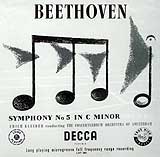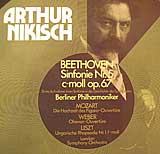 Dit-dit-dit-daaaah. Talk about a great hook! Three quick G's and a long E-flat – the opening of Ludwig van Beethoven's Fifth Symphony just could be the most memorable musical phrase of all time. Three quick G's and a long E-flat – the opening of Ludwig van Beethoven's Fifth Symphony just could be the most memorable musical phrase of all time.
During World War II its suggestion of Morse Code became the powerful symbol of “V For Victory.” GI's who didn't know Schumann from shinola knew this was Beethoven and relished the irony of a German's music galvanizing the Allied effort to defeat the horrific murder machine that country had become. But that's just the first five seconds. In retrospect we revere Beethoven for having ushered in the century of music which most classical fans enjoy the most. While Mozart certainly was pushing in that direction (and might have broken through had he lived past 36), it was the bold harmonic and structural explorations of Beethoven that launched the Romantic era in music, in which personal feelings were no longer repressed beneath conventional form. While the Fifth isn't Beethoven's most innovative or influential symphony (the Third and Ninth compete for that honor) it did have a wealth of ground-breaking features: the first use of a trombone in symphonic music, variations built upon dual themes, two movements joined together, the reprise of an earlier passage in the finale and, most impressive of all, a single motif that unifies the entire work. Beethoven reportedly called his opening “Fate knocking at the door,” “Fate” or not, the commanding opening figure pervades the entire work. The first movement is grim and resolute yet charged with constant conflict and energy as glimmers of hope swirl through a relentless storm. It's a miracle of construction, with all the ideas firmly grounded in that first four-note phrase – even a lyric second theme rides atop and ultimately devolves into it. The focused intensity is relieved by a flowing set of variations, leisurely but with controlled surges of power. Next comes a resolute march built largely upon the insistent rhythm of the opening motif which descends into a hushed section of coiled tension and then explodes into the finale, an exhilarating shout of C-major triumph. In a masterstroke, Beethoven magnifies the effect by summoning again the tense portion of the third movement march and then repeating the triumphant explosion all over again. The work ends in a breathless coda built upon variants of the opening motif to pound home the permanence of the joyous destination.
While Mozart may have written out masterpieces in final form right off the top of his head, Beethoven struggled over the Fifth for nearly a decade. But please don't think of the composer who lavished so much devout care on perfecting his work as a pure soul whose rarified spirit had risen far above the venality of the rest of us mere mortals. Beethoven was all too human – he contracted to sell the Fifth to a wealthy patron for 500 florins (a considerable sum), but after collecting the first 350 turned around without apology or refund and sold the very same score to a publisher. But perhaps it was Beethoven's intense humanity that enabled him to write in a style that appealed to real people, not just aristocrats. That, in itself, is an essential key to understanding Beethoven's lasting appeal. Two centuries ago classical music was wholly dependent upon the patronage of nobility. Public concerts were rare and established professional orchestras unknown. The Fifth was given its world premiere in a massive four-hour concert on December 28, 1808 that consisted entirely of new major Beethoven works, including his Sixth Symphony, Mass in C, Fourth Piano Concerto and Choral Fantasia. By the time the Fifth rolled around that night, the audience was not only too exhausted to have paid much notice but also nearly frozen, as the hall was unheated and the winter bitterly cold. Not surprisingly, the world was hardly transformed by first hearing this glorious creation – the premiere was essentially an exercise in sight-reading, and so notions of sensitivity and interpretive feeling were well beside the point. Nowadays, we've made up for that with a huge variety of distinctive, highly-polished and deeply expressive recordings that plumb the considerable depths of this amazingly rich work. Here are my favorites: Although Arturo Toscanini's reputation as a classical speed demon is largely unwarranted, he does claim the fastest Fifth on records – a stunning concert of May 8, 1945 Politics also flavored the best of Wilhelm Furtwangler's readings. The first was a 1943 Berlin concert (Music & Arts 4049) in which Furtwangler's personal agony is For the opposite extreme to Toscanini, Otto Klemperer, one of the stalwarts of German tradition, stretches his Fifths out to a glorious 40 minutes, At this point you may well ask: does music this great really require extensive interpretation to convey its treasures? No, it certainly doesn't and indeed most conductors, perhaps humbled before Beethoven's genius, let the Fifth speak largely for itself. Among many others, Fritz Reiner and the Chicago Symphony (RCA 68976), Carlos Kleiber and the Vienna Symphony (DG 447 400), Pierre Monteux and the London Symphony (London 443 479) and Herbert von Karajan and the Berlin Philharmonic (EMI and any of three remakes on DG) all present magnificent playing and a satisfying balance of energy and control, drive and repose. And let's not forget the pioneers, who were raised in a era which encouraged personalized interpretation and who present a cavalcade of styles that remain fascinating and influenced all who followed. Often cited as the very first recording of the Fifth (as well as of any full-length symphony) is a set of four Gramophone 78s cut in November 1913 by Artur Nikisch and the Berlin Philharmonic (but released individually over the course of eight months); despite the hardships of the acoustical recording process, this is a magnificent performance, maintaining a firm but gentle balance between power and lyricism, wonderfully balanced, plastically molded and beautifully played. Yet, the Nikisch recording was preceded by at least one other. The true first Fifth was cut by the Odeon Symphony Orchestra led by either Friedrich Kark or Eduard Kuenneke (the scholarship is confusing) in 1910 (or 1911) and issued on the Odeon label. Despite boxy sound that obscured much detail in a sonic blur, Kark/Kuenneke led a swift, no-nonsense reading of spirited playing with an especially riveting first movement (6:30 including the exposition repeat), although the energy dissipates by the plodding finale. Another Fifth by Fran�ois Ruhlmann and an unnamed orchestra on Path� has been variously dated as early as 1912, or possibly 1916. Midway between the rigidity of Kark and the freedom of Nikisch, it boasts sensitive pacing and rhythmic variety, and a surprisingly vivid recording for the time in which tympani and brass fuel the finale. Next came a 1917 Victor set by Josef Pasternack and the Victor Concert Orchestra with fine balance, excellent playing and confident leadership, no doubt due to their vast experience before the recording horn as Victor�s house band and conductor – during his 20-year tenure beginning in 1904 Pasternack led the staggering total of over 3,000 (mostly pop) sides! Although generally moderate, he tempers each appearance of the opening motif with solemn weight, in abrupt contrast to a fleet rendering of the rest of the opening movement. Another notable acoustic set came from HMV in 1921, with the Royal Albert Hall Orchestra conducted by Landon Ronald, who seems to usher in the modern objective style of Beethoven interpretation with steady pacing, subtle tempo adjustments and minimal inflection . that remain fascinating and influenced all who followed. Often cited as the very first recording of the Fifth (as well as of any full-length symphony) is a set of four Gramophone 78s cut in November 1913 by Artur Nikisch and the Berlin Philharmonic (but released individually over the course of eight months); despite the hardships of the acoustical recording process, this is a magnificent performance, maintaining a firm but gentle balance between power and lyricism, wonderfully balanced, plastically molded and beautifully played. Yet, the Nikisch recording was preceded by at least one other. The true first Fifth was cut by the Odeon Symphony Orchestra led by either Friedrich Kark or Eduard Kuenneke (the scholarship is confusing) in 1910 (or 1911) and issued on the Odeon label. Despite boxy sound that obscured much detail in a sonic blur, Kark/Kuenneke led a swift, no-nonsense reading of spirited playing with an especially riveting first movement (6:30 including the exposition repeat), although the energy dissipates by the plodding finale. Another Fifth by Fran�ois Ruhlmann and an unnamed orchestra on Path� has been variously dated as early as 1912, or possibly 1916. Midway between the rigidity of Kark and the freedom of Nikisch, it boasts sensitive pacing and rhythmic variety, and a surprisingly vivid recording for the time in which tympani and brass fuel the finale. Next came a 1917 Victor set by Josef Pasternack and the Victor Concert Orchestra with fine balance, excellent playing and confident leadership, no doubt due to their vast experience before the recording horn as Victor�s house band and conductor – during his 20-year tenure beginning in 1904 Pasternack led the staggering total of over 3,000 (mostly pop) sides! Although generally moderate, he tempers each appearance of the opening motif with solemn weight, in abrupt contrast to a fleet rendering of the rest of the opening movement. Another notable acoustic set came from HMV in 1921, with the Royal Albert Hall Orchestra conducted by Landon Ronald, who seems to usher in the modern objective style of Beethoven interpretation with steady pacing, subtle tempo adjustments and minimal inflection .
Among trailblazers of the electrical recording era A fascinating alternative is one of the “authentic instrument” renditions, which use the smaller orchestras, lower tunings, less powerful instruments and wind- and brass-heavy balances of two centuries ago in an attempt to recreate a performance that Beethoven's audiences would have recognized. It's not a mere gimmick – Beethoven wrote the Fifth for the purpose of being performed, with a specific sound image in mind. While these are the records that really enthuse me, there are plenty of others – 80 in the current Schwann alone (which omits performances that are out of print or only available on certain imports). Some are quite good (ie: Bernstein and the New York Philharmonic on Sony SMK 47516; Szell/Cleveland on Sony SBK 47651) yet just not outstanding. Only a few disappoint – Bernstein's remake with the Vienna Philharmonic (DG) and Munch/Boston (RCA) sound tired; Walter/Columbia (Sony) seems uninvolved and Monteux/San Francisco (Music & Arts) snaps to life with a startlingly vivid first movement but then collapses for the rest (perhaps because it was taken from a different concert). But in truth, I've yet to hear a single record of the Fifth, even by an unknown orchestra and conductor, that's wholly without interest. In reviewing dozens of Fifths for this column, I was struck by how, even after such intensive and repeated exposure, I'm still as enthralled by the work as ever. Indeed, I find myself thirsting for more; I would especially love to have heard what the wildly impulsive Nocolai Golovanov or Albert Coates would have contributed. And that, perhaps, is the strongest proof of Beethoven's genius – this is a work of limitless depth and matchless inspiration that constantly challenges and transcends personal taste and trends.
Copyright 2001 by Peter Gutmann | |
|
For a note about the illustrations, please click here.
| |